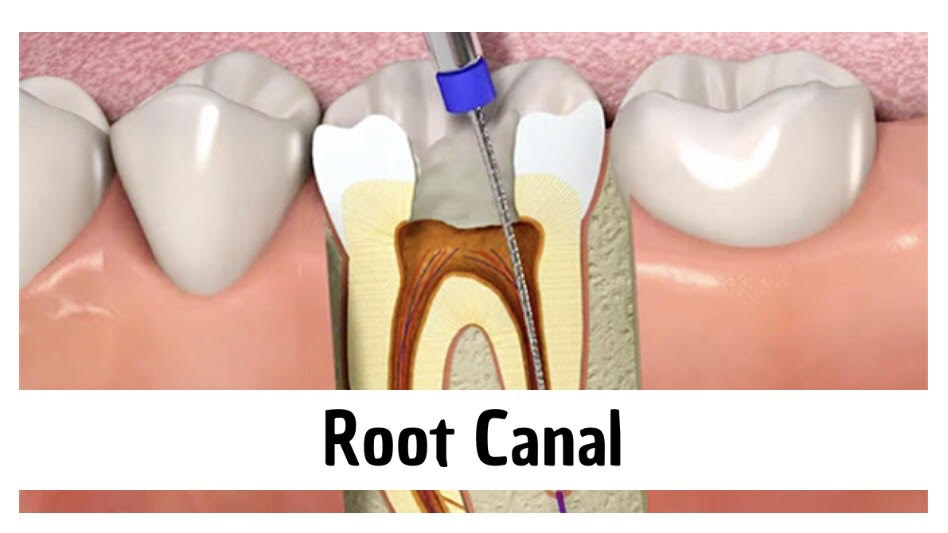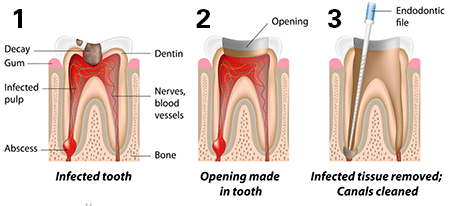- Navigation
- OUR OFFICE
- » MEET OUR DOCTOR
- » MEET OUR STAFF
- » OFFICE TOUR & INFORMATION
- SERVICES
- » FIRST OFFICE VISITS
- » CHILDREN DENTAL CARE
- » PREVENTATIVE CARE
- » COMPOSITE FILLINGS
- » PERIODONTAL
- » ROOT CANAL THERAPY
- » CROWN & BRIDGE
- » EXTRACTIONS
- » DENTURES
- » IMPLANT DENTISTRY
- » WHITENING
- PAYMENTS
- » INSURANCE
- » FINANCING
- » SCHEDULING
- » DENTAL EMERGENCIES
- » SPECIAL OFFERS
- NEW PATIENT
- CONTACT
What is a Root Canal?
A root canal is a treatment used to repair and save a tooth that is badly decayed or becomes infected. During a root canal procedure, the nerve and pulp are removed and the inside of the tooth is cleaned and sealed. Without treatment, the tissue surrounding the tooth will become infected and abscesses may form.
When Is Treatment Needed?
Usually, root canals are recommended or needed when there is an infection deep within the tooth. The pulp inside the tooth can become infected with bacteria because of an injury or because of a severe, untreated cavity. Without treatment, the infection can become severe enough that the tooth has to be removed. If your dentist has recommended the treatment, here is a step-by-step guide of what you can expect during and after the procedure.
How a Root Canal is Performed: Step by Step
As the American Association of Endodontists points out, a root canal is essentially a four-step process. Treatment is usually performed over two office visits.
1. Using a needle, the dentist administers local anesthesia to numb the tooth. It's common to feel a bit of a pinch in the area when the needle goes in. After the tooth is numb, the endodontist might place a dental dam, a small sheet of rubber that isolates the tooth to keep it clean and dry during the procedure.
2. Your dentist will then use very small tools, such as a small drill, to access the inside of the tooth by creating an opening in the top portion of the tooth. Next, the dentist will use small files to clear away the damaged and diseased pulp from the inside of the tooth. He or she will also use the files to shape the inner chamber of the tooth and root and might irrigate the chamber with water to wash away any remaining pulp. Your dentist might also put an antimicrobial solution in the chamber to kill any remaining bacteria and reduce the risk for further infection.
3. Once the chamber is thoroughly cleaned and dried, the endodontist will fill it. A rubber-like material called gutta percha is often used. Your dentist will close the opening in your tooth with a temporary filling, while you wait for the permanent crown.
4. After a few weeks, your dentist will finish the treatment by placing a permanent crown or a similar type of restoration on the top of the tooth. Depending on the condition of your natural tooth, the dentist may need to place a small supporting post inside of the root chamber, to make the crown or restoration more stable.
After the Procedure
Taking good care of your teeth and gums is a must after a root canal. You might need to schedule an additional visit with your dentist to X-ray the treated tooth and to make sure that all signs of infection are gone, in addition to twice-yearly dental cleanings and exams. It's important to keep up a good oral care routine at home, including brushing twice a day with a toothpaste that fights germs for 12 hours, such as Colgate Total Advanced Deep Clean toothpaste. With care and attention, a tooth treated with a root canal can stay healthy for the rest of your life.
© 2012-2017 HQNguyen.com, All Rights Reserved. Designed by Web Tech Enterprise, LLC.



